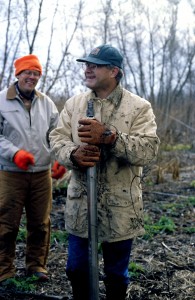Usually, when people think of pollen, sneezing comes to mind. But there’s an entire branch of science that studies pollen – not from the perspective of allergies, but from the stand point of natural history: Palynology. Dr. Eric Grimm is the Director of Sciences at the Illinois State Museum. He’s a palynologist who investigates changes in plant communities and climate in North America through the study of pollen.
How are ancient pollen preserved?
Eric: Most pollen grains consist of just two cells, a vegetative cell and a generative cell When the pollen grain lands on the stigma of an appropriate flower, the vegetative cell germinates to grow a pollen tube down to the ovary of the flower. The generative cell splits into two sperm cells, which swim down the pollen tube and fertilize the ovary. The environmental challenge to these two very small cells is desiccation. To keep from drying out, pollen has evolved a very tough outer shell composed of a material called sporopollenin. The chemical structure of sporopollenin is so complex that it is not exactly known. In any case, it is very resistant to degradation and will preserve indefinitely in the right sedimentary environment, especially a reducing environment (without oxygen). Lake and marine sediments are typically anoxic only a few millimeters into the sediment, and are ideal environments for preservation of pollen grains. Pollen will preserve for millions of years. I’ve seen pollen from the Cretaceous period, some 70 million years ago, that looks like it came off the plant yesterday. These Cretaceous sediments have been compressed into the rock shale, but fossil pollen grains are still composed of the original sporopollenin, which indicates how stable this material is.
How far back in time does the pollen record go in North America? Where are the oldest fossil pollen in north America?
Eric: Spores first appeared the Silurian, some 440 million years ago. Pollen may have first appeared in the Devonian, but for sure by about 340 million years ago the early Mississippian. Fossil spores and pollen are as old as plants. Coal deposits are treasure troves of ancient pollen.
In the Central US Prairie states, what past vegetative changes have you inferred through your research?
Eric: In recent years I have focused on two main issues. The first concerns the timing and nature of vegetation changes following the retreat of the glaciers from the last ice age. The timing question is especially as to whether changes are synchronous over large regions and in particular synchronous with changes seen in the North Atlantic region. The vegetation of this time is said to have “no analog,” which means that although the major species still exist, the combination of these species resembles nothing on the landscape anywhere today. These unusual vegetation types were a response to climatic conditions that were also unlike any today. With global warming, climate is likely headed in a direction that will be unlike any that has existed for millions of years, and how ecosystems respond to different climatic conditions is of relevance. My second interest has been reconstructing very high resolution, decadal scale, records of vegetation and climate change for the past 10,000 years. We don’t have a very good handle on decade to century scale climatic cycles, and understanding these is important for untangling anthropogenic global warming from natural cyclic variations.
What impacts might predicted climate changes have on the prairies?
Eric: That depends on where. The current trends are for drier climate in the southern Great Plains, but wetter climate in the northern Great Plains.
What’s the most interesting aspect of pollen that we might not know?
A grain of globe mallow (Spaeralcea) pollen displays striking symmetry and some serious spines.
Eric: Evolutionarily, pollen is very conservative. Modern molecular genetics, or phylogenetics, is revolutionizing plant classification, because reconstruction of the genetic makeup of plants reveals how plants are truly related. When I’ve seen some new classifications, I’ve said “I could have told you so!” For example, the tree hackberry has traditionally been placed in the elm family. It’s at tree and looks superficially like an elm. However, molecular genetic studies show that hackberry really belongs in the hemp family and is related to hemp, or marijuana, and hops, which is used for beer brewing. Indeed, hackberry has pollen that looks nothing like elm, but does look like hemp and hops!









